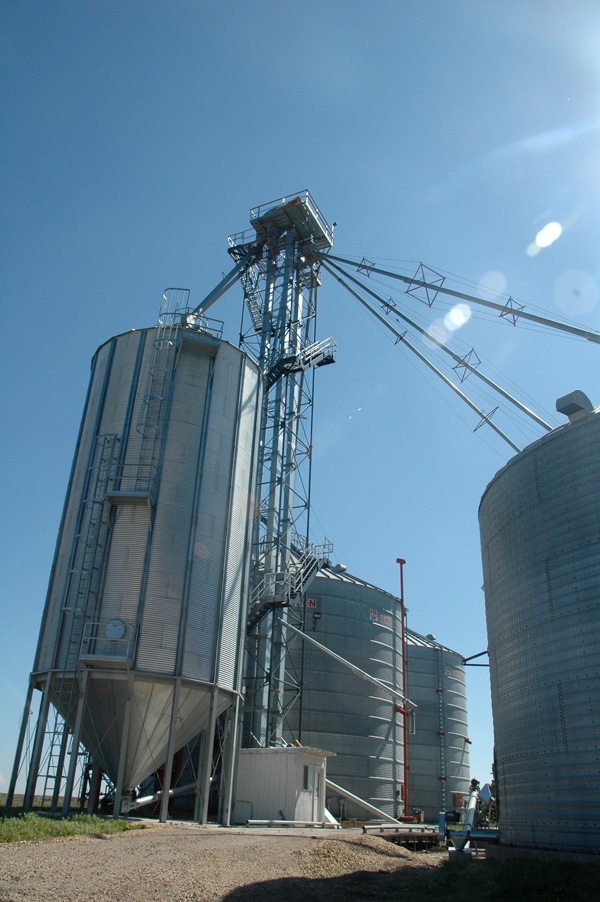September 24, 2012

We are now well into harvest, corn before beans in many cases. This is yet another unusual situation. A lot of corn has been harvested with high outside temperatures, in the 80s and 90s, and was dried in the same conditions. This means corn in bins at much higher temperatures than normal. Early harvest corn will require at least two additional cooling cycles to reach the desired eventual temperature of 40° F or below. The weather forecasts indicate that we will have chances to cool corn in the next week.
A cooling cycle is moving a cooling front completely through a bin and is done when the average outside temperatures are 10-15° F below the grain temperature. With 0.1 cfm/bu. of aeration, this takes about 150 hours; with 1 cfm/bu., about 15 hours is required. Fall storage means progressively lowering the grain temperature in cycles. Because the shelf life of the grain is temperature dependent, it is important to begin these cycles as soon as a 10-15° temperature drop can be achieved. With higher initial temperatures, at least two additional (beyond normal) cycles will be needed. If the grain waits for a month to be cooled, the shelf life will be reduced and future spoilage is much more likely.
Quality is going to vary widely, even in the same field. Expect high and low moisture blends in the same pass. Dryers will not equalize variability; even after cooling and aeration, there can be 4 percentage points or more variation among kernels. Moisture variation means shorter shelf life and more storage risk.
Test weight, the best indicator of storability, will also vary. Overall test weights are somewhat below average, in the 54-55-lb./bu. range, which is what we expected from drought-stressed corn. In severe cases, which can include parts of the same field, 46-50-lb./bu. test weights are likely. The combination of generally lower average test weight and highly variable moisture means we should reduce the typical estimates of storage time before loss. See Crop Quality Issues from the Drought of 2012 for a table of the typical storage life expectations. Reduce these by at least a third, possibly up to 50% for corn from drought-stressed areas.
Aflatoxin continues to be an issue. In Iowa, scattered incidence is occurring, more frequently south of US30 progressively toward the Missouri border. In the northern half of the state, storm-damaged, downed corn is the most susceptible. The recent cooler temperatures have been very helpful in controlling increases in aflatoxin.
It is very important to contact your crop insurance carrier if you suspect aflatoxin, because there is no coverage once the grain is harvested. Know what your markets are doing to monitor aflatoxin. If you have an insurance settlement for aflatoxin, it is very important to market the covered grain to a buyer that will ensure its use by the correct livestock for the level. Food safety is a growing concern in world markets; expect more follow up and tracking if there is a recall or health incident related to aflatoxin.
Aflatoxin will not increase in storage if good grain management practices are followed. Cool the grain immediately after harvest (60° F or below) and dry right away if the corn is over 16% moisture. This is not a good year to hold wet grain for later feeding or blending. However, the fungus is not active in cold grain, so normal drying to 15-16% and progressive aeration cycles will be sufficient.
There is a problematic drying situation this year; bin dryers, even if stirred, should not be operated at “medium” temperatures (80-100° F). These temperatures can create warm corn that could increase in aflatoxin, if the Aspergillus flavus fungus was present in the field, before the grain gets dry. Bin drying at 120° F and up will move the drying more rapidly. Not filling a drying bin to the top at the start of the drying period will also help; less grain will be held at higher moistures.
The FDA has recently approved a temporary blending policy for aflatoxin in Iowa. This policy was released September 19 by the Iowa Department of Agriculture and Land Stewardship. The key point is that if corn is blended to reduce aflatoxin in the blend to useable levels, the blended corn must be marketed with documentation of aflatoxin levels and intended use.We are now well into harvest, corn before beans in many cases. This is yet another unusual situation. A lot of corn has been harvested with high outside temperatures, in the 80s and 90s, and was dried in the same conditions. This means corn in bins at much higher temperatures than normal. Early harvest corn will require at least two additional cooling cycles to reach the desired eventual temperature of 40° F or below. The weather forecasts indicate that we will have chances to cool corn in the next week.
A cooling cycle is moving a cooling front completely through a bin and is done when the average outside temperatures are 10-15° F below the grain temperature. With 0.1 cfm/bu. of aeration, this takes about 150 hours; with 1 cfm/bu., about 15 hours is required. Fall storage means progressively lowering the grain temperature in cycles. Because the shelf life of the grain is temperature dependent, it is important to begin these cycles as soon as a 10-15° temperature drop can be achieved. With higher initial temperatures, at least two additional (beyond normal) cycles will be needed. If the grain waits for a month to be cooled, the shelf life will be reduced and future spoilage is much more likely.
Quality is going to vary widely, even in the same field. Expect high and low moisture blends in the same pass. Dryers will not equalize variability; even after cooling and aeration, there can be 4 percentage points or more variation among kernels. Moisture variation means shorter shelf life and more storage risk.
Test weight, the best indicator of storability, will also vary. Overall test weights are somewhat below average, in the 54-55-lb./bu. range, which is what we expected from drought-stressed corn. In severe cases, which can include parts of the same field, 46-50-lb./bu. test weights are likely. The combination of generally lower average test weight and highly variable moisture means we should reduce the typical estimates of storage time before loss. See Crop Quality Issues from the Drought of 2012 for a table of the typical storage life expectations. Reduce these by at least a third, possibly up to 50% for corn from drought-stressed areas.
Aflatoxin continues to be an issue. In Iowa, scattered incidence is occurring, more frequently south of US30 progressively toward the Missouri border. In the northern half of the state, storm-damaged, downed corn is the most susceptible. The recent cooler temperatures have been very helpful in controlling increases in aflatoxin.
It is very important to contact your crop insurance carrier if you suspect aflatoxin, because there is no coverage once the grain is harvested. Know what your markets are doing to monitor aflatoxin. If you have an insurance settlement for aflatoxin, it is very important to market the covered grain to a buyer that will ensure its use by the correct livestock for the level. Food safety is a growing concern in world markets; expect more follow up and tracking if there is a recall or health incident related to aflatoxin.
Aflatoxin will not increase in storage if good grain management practices are followed. Cool the grain immediately after harvest (60° F or below) and dry right away if the corn is over 16% moisture. This is not a good year to hold wet grain for later feeding or blending. However, the fungus is not active in cold grain, so normal drying to 15-16% and progressive aeration cycles will be sufficient.
There is a problematic drying situation this year; bin dryers, even if stirred, should not be operated at “medium” temperatures (80-100° F). These temperatures can create warm corn that could increase in aflatoxin, if the Aspergillus flavus fungus was present in the field, before the grain gets dry. Bin drying at 120° F and up will move the drying more rapidly. Not filling a drying bin to the top at the start of the drying period will also help; less grain will be held at higher moistures.
The FDA has recently approved a temporary blending policy for aflatoxin in Iowa. This policy was released September 19 by the Iowa Department of Agriculture and Land Stewardship. The key point is that if corn is blended to reduce aflatoxin in the blend to useable levels, the blended corn must be marketed with documentation of aflatoxin levels and intended use.
You May Also Like




